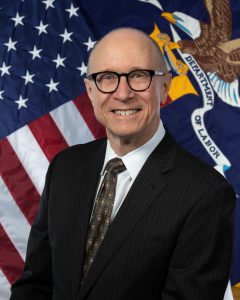Meet William Beach, Commissioner of the Bureau of Labor Statistics
Amstat News invited William Beach, commissioner of the Bureau of Labor Statistics (BLS), to respond to a few questions so readers can learn more about him and the agency he leads.
What about this position appealed to you?
I was excited about the opportunity to be the commissioner of Bureau of Labor Statistics, which would give me the chance to lead a statistical agency that produces gold standard data and is respected throughout the world. Plus, this appointment seemed like a great fit, because I have used BLS data throughout my career—from graduate school through work in the think tanks, as chief economist to the Senate Budget Committee and, most recently, as vice president of policy research at George Mason University.
I believe in our mission, which is to help Americans make better decisions by measuring many key facets of the US economy, including employment and unemployment, compensation, worker safety, productivity, price trends, consumer spending patterns, and Americans’ use of time.
Describe the top priorities you have for the Bureau of Labor Statistics.
First, it is crucial we continue to stand as the premier economic data organization in the world, either public or private. Although BLS is the gold standard against which every other statistical organization judges their quality, we need to continually improve and enhance the way we do business to remain the gold standard.
Second, it is crucial we all remain curious about how the economic world works. That world is rapidly changing, perhaps at a pace not seen since the reconstruction of major European and Asian economies following World War II. Globalization has produced enormous benefits for most people as it has restructured wide swaths of economic activity. It has also reshaped the income profiles of people in both developed and developing countries. Statistical agencies around the world must be keenly attuned to these economic changes and filled with analysts who are focused on understanding these changes, capturing them, and building them into mainline economic and social theory.
What do you see as the biggest challenge(s) for BLS?
Declining response rates and data protection are the biggest challenges facing BLS. These are actually related because our respondents are more likely to participate in voluntary surveys if they are confident their data is safe and confidential. At the same time, the general public is more likely to trust our data as the gold standard if we can prevent it from being manipulated by outsiders. We know many people would have much to gain by manipulating or obtaining our data prior to official release. And a successful cyberattack or data breach/leak of some sort would be devastating to us as an independent, objective agency. Thus, the security and confidentiality of the information provided by respondents are vital to the reputation of BLS.
I am impressed and reassured by how BLS supervisors and managers stress the importance of security and confidentiality to new employees, from their first day on the job. We are constantly growing a staff that takes these issues seriously.
What kind of support from the statistical community do you look for?
One of the key themes of the Foundations for Evidence-Based Policymaking Act (the evidence act) is that the federal government must better use all data gathered by its statistical agencies. To successfully meet the multiple mandates of the first implementation phase of the evidence act, members of the statistical community must come together and assist one another. BLS will provide the necessary resources and expertise to meet these requirements.
One advantage of the US system of statistical agencies is the subject-matter expertise each agency has built and the potential to coordinate with experts who handle policy and regulation. For example, the BLS program on occupational safety and health statistics works closely with the Occupational Safety and Health Administration (OSHA) on definitions and concepts, which benefits BLS in its statistical work and OSHA in their regulatory mission.
Prior to your tenure, what did you see as the biggest recent accomplishment of the agency?
Of all the great work done every day at BLS, two recent items come to mind. First, the American Time Use Survey just released 2017–2018 estimates of access to and use of leave and job leave and flexibilities. This data was collected during a module sponsored by the US Department of Labor (DOL) Women’s Bureau.
Second, we recently produced experimental state Job Openings and Labor Turnover Survey (JOLTS) estimates using various statistical models. The National Council for the American Worker wants BLS to continue producing these experimental estimates and explore expanding the JOLTS sample to produce sample-based estimates for states and metropolitan areas. We have shared information about this potential expansion with the Office of Management and Budget and are currently working within the DOL on options for expanding our JOLTS sample, including budget options.


















